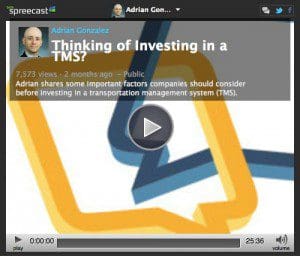Managing transportation — the ebb and flow of rates, capacity, fuel and regulations — is an ongoing challenge for many companies, especially those still using spreadsheets and fax machines to plan and execute shipments. At some point, usually when costs are out of control or service levels are heading south, companies finally make the decision to invest in a transportation management system (TMS) or outsource all or part of their transportation operations to a third party.
In my experience, when companies start exploring the TMS investment option, they immediately rush to create a list of desired features and functions. While developing such a list is important, companies should do it later in the process, after they have taken other factors into consideration.
Here are four important, yet often overlooked, factors companies must consider before investing in a transportation management solution:
Is it time to redesign your transportation network? Put differently, do you have the most efficient and effective transportation network design, not only relative to your current operating realities, but also relative to where your business is heading in the coming years? If you plan to shift more of your transportation volume from trucking to rail or intermodal in the years ahead, for example, then you need to model and simulate that scenario to understand the impact on costs, service levels, and other factors. The same is true if you plan to open more stores or distribution centers in new locations, expect to grow your ecommerce operations, want to implement DC-bypass, are thinking of providing same-day delivery, and so on. As the great Yogi Berra famously said, “You’ve got to be very careful if you don’t know where you’re going, because you might not get there” — or in this case, you might end up with a transportation management solution that doesn’t meet your longer-term operational and strategic needs.
How will you establish and manage electronic communication with carriers and other trading partners? Historically, one of the most labor-intensive and time-consuming aspects of a traditional TMS implementation is connectivity — i.e., establishing electronic communication with carriers, suppliers, logistics service providers, and other external trading partners. And since these trading partner networks are continuously changing, establishing and maintaining connectivity with hundreds or even thousands of partners is an ongoing challenge — and cost factor. Therefore, companies must take into account the time, cost, and resources required, upfront and on an ongoing basis, to enable and manage a connectivity network. How long does it take you to onboard a new carrier or trading partner, and how much does it cost? How often do you have to onboard or deactivate trading partners? How often do you have to modify data maps, how much time does it take, and at what cost? The bottom line is that network connectivity is not a core competency for many companies, which is why software-as-a-service (SaaS) solutions, which come with a built-in network of carriers and trading partners, have been gaining traction in the industry.
Do you have the resources internally to effectively use and manage a TMS? Like all software applications, a TMS is just a tool — you also need power users who have the training, knowledge, and skills to leverage the application to its fullest potential. In fact, one of the main reasons why TMS solutions sometimes fail to provide sustained value is when a power user leaves the company and there isn’t someone (or ideally, a team) with the requisite skills and experience to fill the void. Therefore, companies have to understand that investing in a TMS is not enough — they also have to invest in transportation analysts, planners, and dispatchers, and in continuous training and talent development programs. Alternatively, companies can partner with a managed transportation services provider that effectively combines a software-as-a-service TMS with power users — i.e., provides not just the technology, but also experienced supply chain experts who can connect all the pieces together (software, process changes, metrics, best practices, continuous improvement, etc.) to deliver sustained business value.
Do you have the skills and discipline to keep the TMS tuned? It takes time to set up and fine tune a TMS, particularly its optimization capabilities, so that it accurately reflects your transportation operations. And since your operations change over time — routing guide, rates, lead times, delivery windows, optimization constraints, and so on — you need to continuously fine tune the TMS, otherwise the quality of the output will degrade and you’ll end up thinking the solution is “broken” and stop using it. Unfortunately, many companies don’t review and adjust their TMS setup after the initial implementation, and most TMS vendors have dropped the ball when it comes to helping clients “tune up” their systems. Simply put, a TMS is like a car – you have to schedule regular tune-ups or else its performance will start to degrade. This is yet another reason why investing in talent is an important factor, either directly or by partnering with a managed transportation services provider that conducts these TMS tune-ups as part of its ongoing service.
So before you rush to decide on a transportation management solution, answer the four questions above first. The answers will ultimately point you in the best direction forward.
For additional thoughts on this topic, watch my Talking Logistics episode from March, our most-watched episode to date.
(Note: This posting was originally published as a guest commentary on C.H. Robinson’s blog, Transportfolio. C.H. Robinson is a Logistics Viewpoints sponsor.)

















